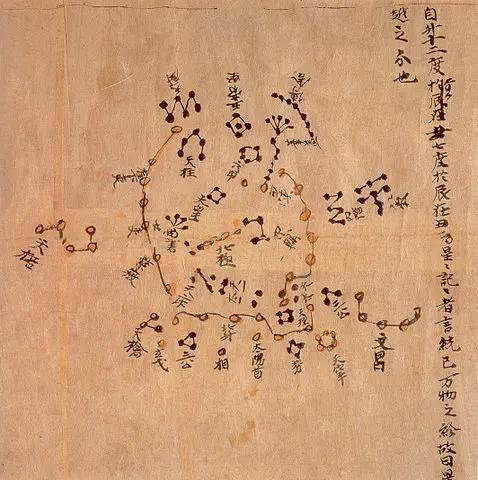Chinese people have long looked at and studied the stars and the night sky. There are ancient maps of the sky from Ancient China and astronomers have used the stars, the planets and the moon to tell the time, predict the future, navigate and solve problems.
Astronomers from Ancient China learnt a lot from Indian astronomers, but they also had some very advanced ideas of their own.
Stars to tell the time
The main reason for studying stars in Ancient China was to tell the time and to work out the calendar, which was based on either the moon or the stars. During each dynasty, an astronomer would develop a new calendar for the emperor.

Stars to predict the future
Another important reason to study stars and the night sky was to carry out divination. Divination was a way of figuring out unknown things by using rituals. In this case, certain stars or events were used to predict events.
Indian and Chinese astronomical connections
Astronomy in China was very much influenced by India. When Buddhism spread around China (around 25-220 AD), lots of books about Indian astronomy were translated into Chinese.
Much later, the famous table of sines by the Indian astronomer, Aryabhata (476-559 AD) was translated into the Chinese book, the Treatise on Astrology of the Kaiyuan Era, completed in 718 AD during the Tang Dynasty. The table of sines was a table of angles and mathematical values that helped scholars work out navigation, mathematical problems and study the night sky.

The shape of the universe
There were three theories in Chinese about how the universe was shaped and what it looked like (cosmology).
- Gai Tian theory was that the universe was dome shaped. They thought the earth was dome shaped and the heavens were above it.
- Hun Tian theory was that the heavens were a sphere. This theory was similar to the one in Ancient Greece.
- Xuan Ye theory thought that the heavens were infinite (never ending) and that other parts of the universe were floating around.
Mapping the stars
The Chinese divided all the stars in the sky into the 28 mansions, a bit like the zodiac constellations in the Western world. There is an early record of these categories (the 28 mansions) on a lacquer box that dates from 433 BC.
The earliest star catalogues from the 4th century BC were written out in the book of Shi Shen (Shi Shen Astronomy) and Gan De (Astronomic Star Observation).

No-one really knows when the earliest star maps are from. That is because there are some very early maps of the stars on pottery. Scholars have suggested that these pottery drawings of stars are the earliest star maps.
There is a very old star map drawn out by Su Song in 1092 AD.
There is a very famous star map that was found in Dunhuang by the British archaeologist Marc Aurel Stein in 1907. We think this is the earliest true star map in the world. This map is now at the British Museum in London. It shows more than 1,350 stars.
Quiz
Chinese astronomers were very knowledgeable about the night sky…how knowledgeable are you about Chinese astronomy? Test yourself with these quick questions
- Why did Chinese astronomers study the stars?
- Which country influenced Chinese astronomy?
- What was the earliest star map?
- Where is the earliest star map now held (which museum)?
- How many stars are on the earliest star map?
Answers
- To tell the time or predict the future
- India
- The Dunhuang star map
- The British Museum (London)
- Over 1,350